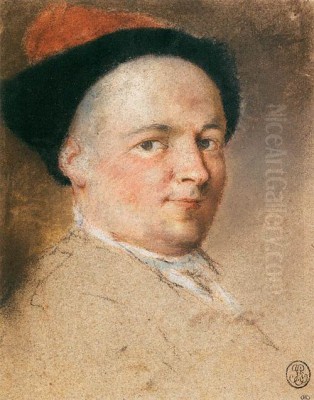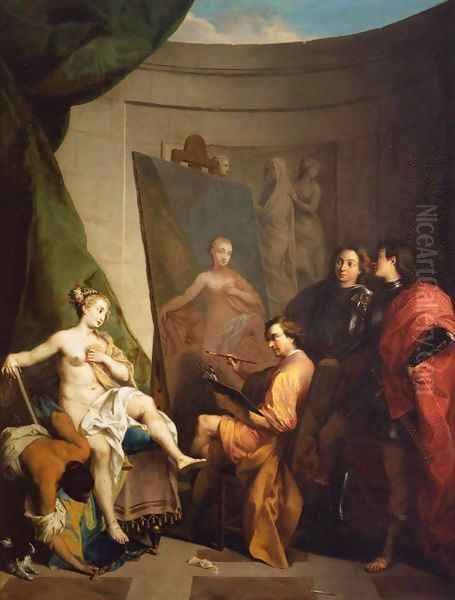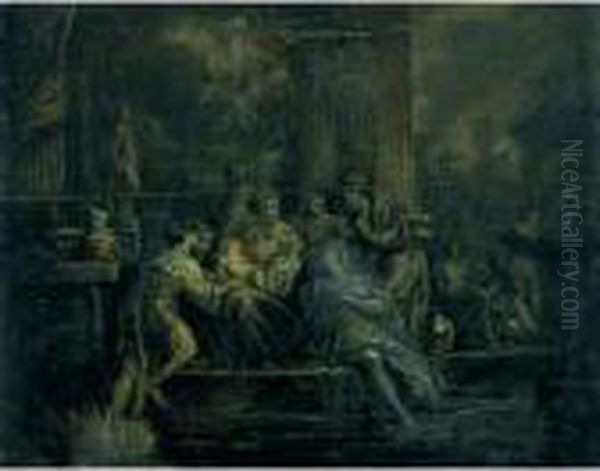
Nicolas Vleughels (1668-1737) stands as a significant, if sometimes overlooked, figure in the landscape of early 18th-century European art. While perhaps not celebrated for a revolutionary personal artistic style on par with some of his contemporaries, Vleughels's enduring legacy is cemented by his crucial role as an administrator, educator, and cultural intermediary, particularly during his tenure as director of the French Academy in Rome. His life and career offer a fascinating window into the artistic networks, pedagogical practices, and international dialogues that shaped the transition from the late Baroque to the burgeoning Rococo and Neoclassical sensibilities.
Early Life and Artistic Formation in Paris
Born in Paris in 1668, Nicolas Vleughels was immersed in the world of art from his earliest days. His father, Philippe Vleughels, was a Flemish painter who had established himself in the French capital, providing young Nicolas with his initial artistic instruction. This paternal tutelage grounded him in the rich traditions of Flemish painting, known for its vibrant color, dynamic compositions, and often, a robust realism. The influence of masters like Peter Paul Rubens and Anthony van Dyck, whose works were highly prized and studied, would have been part of his early artistic environment.
To further hone his skills, Vleughels also studied under Pierre Mignard (1612-1695). Mignard was a dominant figure in French art, a rival to Charles Le Brun, and a celebrated portraitist and painter of large-scale decorative schemes. Training with Mignard would have exposed Vleughels to the prevailing French academic tradition, emphasizing drawing, classical composition, and a certain refined elegance. Vleughels became particularly noted in his early years for his skill in copying the works of Rubens, an exercise that was a common and respected part of artistic training, allowing young painters to absorb the techniques and compositional strategies of established masters. This practice demonstrates his early engagement with the Flemish Baroque, a style that would continue to inform his understanding of color and dynamism.
The Italian Sojourn: Rome and Venice

In 1694, like many ambitious artists of his time, Vleughels embarked on a journey to Italy, the veritable cradle of classical and Renaissance art, and a vital finishing school for any aspiring painter. He spent a significant period, reportedly around two years, primarily in Rome and Venice. This Italian sojourn was transformative. Rome, with its unparalleled ancient ruins, Renaissance masterpieces by artists like Raphael and Michelangelo, and the powerful Baroque statements of Gian Lorenzo Bernini and Caravaggio, offered an overwhelming visual and intellectual feast.
Venice, with its unique artistic heritage, also left a profound mark on Vleughels. The Venetian school, celebrated for its mastery of color and light, particularly the works of Titian, Tintoretto, and notably Paolo Veronese, deeply influenced him. Veronese’s grand-scale decorative canvases, with their opulent colors, complex figural arrangements, and festive atmosphere, resonated with Vleughels. The impact of Venetian colorism can be discerned in his later works, tempering the more somber palettes sometimes found in the French tradition. This period in Italy was not just about passive observation; it involved active study, sketching, and absorbing the diverse artistic currents that flowed through these cultural capitals.
Return to Paris and Academic Ascent
Vleughels returned to Paris around 1709, his artistic sensibilities enriched and broadened by his Italian experiences. He gradually established himself within the Parisian art world. A significant milestone in his career came in 1716 when he was received as a full member of the prestigious Académie Royale de Peinture et de Sculpture (Royal Academy of Painting and Sculpture). Membership in the Academy was a mark of official recognition and opened doors to royal commissions and influential patronage.
His reception piece for the Academy was likely a work that demonstrated his skill in history painting, the most esteemed genre at the time. During this period in Paris, he continued to paint, teach, and engage with the city's vibrant artistic community. It was also during these years that his close friendship with Jean-Antoine Watteau (1684-1721), a pivotal figure in the development of the Rococo style, flourished. Their association was mutually beneficial, involving shared living quarters for a time and, undoubtedly, rich artistic dialogue.
Director of the French Academy in Rome: A Defining Role
The most defining chapter of Nicolas Vleughels's career began in 1724 when he was appointed director of the French Academy in Rome (Académie de France à Rome), a position he held with distinction until his death in 1737. The French Academy in Rome, housed in the Palazzo Mancini, was a crucial institution for training promising French artists, winners of the prestigious Prix de Rome. Under Vleughels's leadership, the Academy's status and influence grew considerably.

Vleughels was more than just an administrator; he was an active and engaged director who sought to modernize and invigorate the Academy's curriculum and atmosphere. He understood the importance of direct engagement with both the art of the past and the living environment of Italy. He encouraged students to move beyond rote copying in the studio and to engage in practices like outdoor sketching (plein air), capturing the Roman Campagna's landscapes and the city's vibrant street life. This was a forward-thinking approach that anticipated later trends in landscape painting.
He also facilitated access for students to important private collections in Rome, broadening their exposure to a wider range of masterpieces. His directorship was characterized by a push towards greater centralization and internationalization. He fostered a lively intellectual and artistic environment, encouraging experimentation and a degree of free expression among the students. He understood that Rome was not just a repository of old masters but a living artistic center, and he encouraged interaction with contemporary Italian artists.
During his tenure, many talented young French artists passed through the Academy, benefiting from his guidance and the environment he cultivated. Figures like the painter Charles-Joseph Natoire (1700-1777), who would himself later become director of the Academy, and Étienne Jeaurat (1699-1789), known for his genre scenes, were among those who studied in Rome during Vleughels's directorship. While Jean-Honoré Fragonard (1732-1806) arrived in Rome later, the robust foundation and international outlook Vleughels instilled in the Academy undoubtedly contributed to the enriching experience for subsequent generations of artists. His efforts helped to ensure that the French Academy in Rome remained a premier institution for artistic training and a vital hub for Franco-Italian cultural exchange.
Artistic Style and Representative Works
While Vleughels's administrative and educational contributions often overshadow his personal artistic output, he was a competent and active painter throughout his career. His style reflects the diverse influences he absorbed: the solidity of the Flemish tradition from his father, the refined classicism of Mignard, and the rich colorism of the Venetian school, particularly Veronese. His work generally aligns with the late Baroque, but with an elegance and sometimes a lightness that hints at the emerging Rococo. He primarily painted historical, mythological, and religious subjects, as was common for academically trained artists of his era, but he also produced portraits and genre-like scenes.
One of his most recognized works is "Apelles Painting Campaspe" (1716), now housed in the Louvre Museum in Paris. This painting depicts the famous story from antiquity where Alexander the Great commissions his court painter, Apelles, to paint his favorite mistress, Campaspe. Apelles falls in love with Campaspe while painting her, and Alexander, in a magnanimous gesture, gives her to the artist. The subject itself celebrates the power and status of the artist. Vleughels’s treatment of the theme showcases his skill in composition, his ability to render figures with anatomical correctness, and a rich, if somewhat restrained, palette. The work demonstrates his academic training and his engagement with classical themes.
Other works attributed to him, or known through records, explore similar historical or allegorical narratives. He was adept at creating complex multi-figure compositions, often imbued with a sense of theatricality. While his paintings may not possess the groundbreaking originality of a Watteau or the dramatic intensity of a Caravaggio, they are accomplished pieces that reflect the high standards of craftsmanship prevalent in the period. His understanding of light and shadow was proficient, and his drawing was sound, reflecting his rigorous academic background.
His time in Venice clearly left its mark, and some of his works exhibit a brighter palette and a more fluid brushwork reminiscent of Venetian masters. He was also known to collaborate or be closely associated with decorative schemes, a common practice for artists of his standing.
Networks and Relationships: A Socially Adept Artist
Nicolas Vleughels was not an isolated artist but a well-connected figure within the European art world. His social skills and amiable personality undoubtedly contributed to his success as an administrator and facilitated his interactions with a wide range of individuals.
His friendship with Jean-Antoine Watteau is perhaps his most famous personal connection. They reportedly lived together for a period in Paris, and Watteau even included a portrait of Vleughels, dressed in a distinctive Armenian costume (or as a bagpiper, depending on interpretation), in his celebrated painting "Fêtes Vénitiennes" (Venetian Festivities, c. 1718-1719). This inclusion speaks to their close bond and mutual respect. They shared an admiration for Rubens and Van Dyck, and likely spent considerable time discussing art and studying masterworks together. Watteau's delicate Rococo sensibility was quite different from Vleughels's more robust style, but their friendship highlights the interconnectedness of the Parisian art scene.
In Rome, Vleughels cultivated relationships with influential patrons and collectors, such as the renowned connoisseur Pierre Crozat, whose collection was legendary and whose circle included many leading artists and intellectuals. Access to such collections was invaluable for Vleughels himself and for the students under his charge. His correspondence reveals interactions with figures like the sculptor Pierre Le Gros the Younger (1666-1719), another prominent French artist working in Rome.
He also engaged with Italian artists, including the celebrated Venetian pastellist Rosalba Carriera (1673-1757), who visited Paris and was a sensation there. Vleughels's position as Director of the French Academy naturally placed him at the center of a network of French and Italian artists, diplomats, and cultural figures. He corresponded with artists and patrons across Europe, further underscoring his role as a conduit for artistic ideas and opportunities. His students, such as Étienne Jeaurat and Nicolas Delobel (1693-1763), also formed part of his immediate circle, benefiting from his guidance and connections. The painter Subleyras, Pierre (1699-1749), another significant French artist active in Rome, would also have been part of this milieu, eventually marrying the miniature painter Maria Felice Tibaldi. The environment Vleughels fostered was one of collaboration and exchange, vital for the artistic development of those within his orbit. Other artists like Jean-François de Troy (1679-1752), who also served as Director of the French Academy in Rome after Vleughels, continued to build on the foundations he laid.
Pedagogical Innovations and Influence
As an educator, Vleughels was progressive for his time. His emphasis on students drawing from nature, including landscape sketching in the Roman Campagna, was a departure from the more rigid academic focus on copying antique sculpture and Renaissance paintings exclusively within the studio. This practice encouraged a more direct observation of light, atmosphere, and natural forms, which would become increasingly important in the development of landscape painting in the later 18th and 19th centuries. Artists like Claude-Joseph Vernet (1714-1789), known for his landscapes and seascapes, benefited from this evolving pedagogical environment at the Academy, even if his main period there was slightly after Vleughels's directorship.
Vleughels also championed the study of a diverse range of masters, not limited to the High Renaissance canon. His own appreciation for Rubens and the Venetian school likely informed his encouragement of students to study artists known for their color and dynamism. He fostered an environment that, while still rooted in academic principles, allowed for a degree of individual exploration and experimentation. This was crucial in a period where artistic styles were in flux, with the Rococo gaining prominence and early Neoclassical ideas beginning to stir.
His leadership style was reportedly one that encouraged dialogue and provided supportive mentorship. He understood that the goal of the Academy was not merely to produce technically proficient copyists but to nurture artists who could contribute meaningfully to the French school. The success of students who passed through the Academy during his tenure, like Natoire and Jeaurat, attests to the quality of the education and the stimulating environment he helped create. His influence, therefore, extended beyond his own canvases to the subsequent generation of French artists who were shaped by their Roman experience under his guidance.
Legacy and Historical Significance
Nicolas Vleughels's historical significance lies predominantly in his transformative directorship of the French Academy in Rome. While art history tends to prioritize groundbreaking individual artistic genius, the roles of educators, administrators, and cultural facilitators are equally vital to the health and evolution of the art world. Vleughels excelled in these capacities. He elevated the French Academy in Rome, making it a more dynamic and influential institution. His efforts to modernize its teaching methods and broaden its international connections had a lasting impact.
His advocacy for Franco-Italian artistic exchange was crucial. In an era before mass media and easy travel, institutions like the French Academy in Rome, and individuals like Vleughels, were essential conduits for the transmission of artistic ideas, styles, and techniques across borders. He helped to ensure that French artists remained deeply engaged with the classical and Renaissance heritage of Italy, while also being exposed to contemporary Italian art.
While his own paintings are not considered to be at the forefront of artistic innovation for his time, they are competent and representative of the period's academic standards. His true masterpiece, it could be argued, was the revitalized French Academy in Rome itself. He left a legacy of a well-managed, forward-looking institution that continued to train generations of important French artists, including later luminaries like Jacques-Louis David (1748-1825) and Jean-Auguste-Dominique Ingres (1780-1867), who would pass through its halls long after his death, benefiting from the standards and traditions he helped to establish.
The esteem in which he was held is evidenced by the fact that after his death in Rome in 1737, a monument was erected in his honor at the Academy, a testament to his contributions. He is remembered as a dedicated artist, an inspiring teacher, and a skilled administrator who played a key role in shaping the artistic landscape of the early 18th century.
Conclusion: A Multifaceted Contributor to Art History
Nicolas Vleughels emerges from the annals of art history not primarily as a painter who radically altered the course of art with his own brush, but as a figure whose intelligence, dedication, and interpersonal skills enabled him to make profound contributions in other ways. His early training under his father, Philippe Vleughels, and Pierre Mignard, combined with his formative experiences in Italy and his deep study of masters like Rubens and Veronese, equipped him with a broad understanding of art.
His friendship with Watteau and his interactions with patrons like Pierre Crozat and artists like Rosalba Carriera and Pierre Le Gros place him firmly within the vibrant artistic networks of his time. However, it was his thirteen-year tenure as Director of the French Academy in Rome that truly defined his legacy. He transformed the Academy into a more dynamic, internationally-minded institution, fostering a generation of artists including Natoire and Jeaurat, and laying groundwork that would benefit future students. His emphasis on diverse study methods, including outdoor sketching, and his role in promoting cultural exchange between France and Italy, mark him as a significant and forward-thinking figure in the history of art education and administration. Nicolas Vleughels, therefore, deserves recognition as a pivotal architect of the artistic environment of the early eighteenth century.